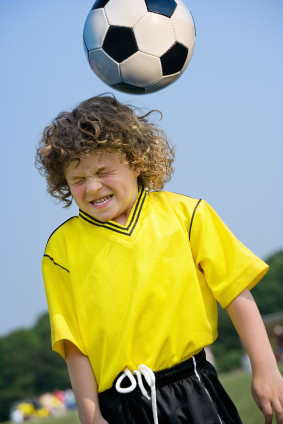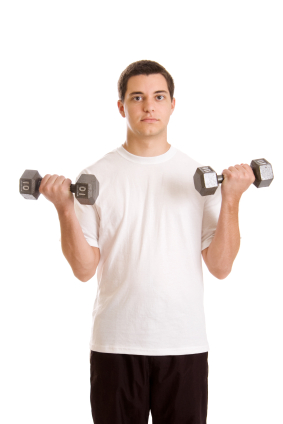Balanced neck strength may reduce the acceleration of the head during the act of heading a soccer ball, thus reducing the risk of brain injury from such low grade hits, says a 2013 study (1). The study adds to a growing body of evidence that strengthening neck muscles may be a way to reduce head injury risk from concussion and repetitive sub-concussive trauma. 
Researchers at Albany (NY) Medical College and Rensselaer Polytechnic Institute analyzed video of college soccer players using a motion capture system and measured neck flexor and extensor strength using a dynanometer. They found a positive correlation between neck strength difference and angular head acceleration (blows causing a twisting or "spinning" of the head) resulting from low-velocity impacts between the head and ball, and a trend towards statistical significance for linear head acceleration (straight on impact).
Minimizing head acceleration has been a focus in recent research in many sports, including football, rugby, lacrosse, and soccer. Because protective headgear has not been shown to be efffective in reducing concusions in soccer (2), other risk reduction strategies are being explored.
In soccer, evidence suggests that heading technique, neck muscle strength, and head size are risk factors, "with modeling of head and neck motion identifying the stiffening effect that muscles adopt when experienced players anticipate a head to ball contact," says the study. This muscle stiffening may, experts believe, "absorb the kinetic energy of the ball by the head and torso rather than just the head, thus minimizing the acceleration that the head experiences."
A growing number of concussion experts (3), strength and conditioning trainers (4), and physical therapists, believe that strengthening the neck may reduce the risk of concussion, the theory being that stronger neck muscles will help cushion against and lessen the linear and rotational forces that cause concussion.
The new study adds to a growing body of evidence on the benefits of neck strengthening as a way to reduce brain trauma from concussion and repetitive sub-concussive blows, most recently the results of a 2014 study (5) suggesting that overall neck strength is a statistically significant predictor of concussion, with the odds of concussion falling by 5% for every one pound increase in aggregate neck strength. The data in that study also showed that the quarter of the subject group of more than six thousand high school athletes playing boys' and girls' soccer, basketball, and lacrosse with the weakest necks suffered the greatest number of concussions, while the quartile with the strongest necks suffered the fewest.
May benefit younger players
While most studies suggest that heading is not associated with the highest risk of concussion in experienced soccer players (player-to-player contact, and player-to-ground contact are the cause of most concussions in soccer), the risk is probably greater for less experienced players, the study notes, especially "children learning the game [who] have a greater head-to-ball size ratio and lower neck strength, putting them at risk for head injury.
"Achieving and maintaining a balance in neck strength may be a key preventive technique in limiting acceleration, hence limiting the potential risks of repetitive heading in soccer," writes lead author Zachary D.W. Dezman, M.D. "Balancing muscles may be particularly beneficial," Dr. Dezman writes, "for younger players learning the game and would perhaps be a more objective, quantitative parameter when deciding when to introduce heading," rather than strict age limits, as are imposed by some soccer programs, such as the AYSO (6) as recommended by some experts, including Dr. Robert Cantu in his recent book, "Concussions and Our Kids" (7), or by some organizations, which have recently called for discouraging heading before the age 14. (10)
The study suggests that "neck strength assessment could be used for pre-participation screening of soccer players to identify those most at risk and strengthening regimens employed during preseason conditioning to lower the risk of injury during soccer participation," similar to strength and conditioning interventions which have been successful in reducing the incidence of anterior cruciate ligament injury in girl's soccer (8, 9).
"The results are promising and support what those of us caring for athletes believed to be true, based on our observations, who see strengthening the neck musculature as a means of reducing the risk of sport-related concussion," said William P. Meehan, III, M.D., Director of the Sports Concussion Clinic and the Micheli Center for Sports Injury Prevention in the Division of Sports Medicine at Children's Hospital Boston, and a MomsTEAM concussion expert.
Neck strengthening exercises
Fortunately, neck strengthening exercises are easy to do and don't require a huge investment in equipment.
Here are some simple strengthening exercises Dr. Meehan says athletes can add to their current resistance training:
- Shrugs: A common resistance exercise which can be performed either with a barbell or dumbbells. The easiest way may be for the athlete to hold a dumbbell of appropriate weight in each hand, with the arms extended at the side, and then raise their shoulders, lifting the weight of the dumbbell, and then slowly relaxing to the starting position.
- Dumbbell press: For the dumbbell press, the athlete raises their arms so that the elbows are even with the shoulders and flexed at approximately 90 degrees. From this starting position, the athlete then raises the dumbbell toward the ceiling while
 straightening the elbow. Then, the dumbbell is returned to the starting position.
straightening the elbow. Then, the dumbbell is returned to the starting position. - Lateral, forward, backward, and rotational resistance exercises of the neck. Athletes playing for teams with significant resources will often have a machine that is specifically designed to help them strengthen the neck muscles. There are, however, some very simple resistance exercises athletes without such resources can still do which are perhaps the easiest and most effective ways to strengthen the neck muscles.
In order to perform lateral resistance exercises, an athlete places their right hand on the right side of their head. The muscles of the neck are flexed so that the right ear attempts to move downward towards the right shoulder, but, because the athlete is resisting that action, the head doesn't actually move. The athlete should hold this position in active resistance for about 5 to 10 seconds. The exercise can then be performed on the left side of the head, front of the head, and back of the head.
The rotational resistance exercises are similar: the athlete places their hand against the side of the forehead and then attempts to rotate the head towards the right or the left while nodding "no." This motion is resisted by the hand so there is no actual movement of the head. Again, the athlete should hold the position in active resistance for about 5 to 10 second and then repeat in the opposite direction.
Proper supervision on technique
As with all resistance training, particularly in younger athletes, the emphasis should be on proper and safe technique. Younger athletes who are unfamiliar with resistance training should be coached and supervised by an adult with expertise in resistance training of the pediatric athlete. The descriptions outlined above are for descriptive purposes only; anyone planning on engaging in them should consult a proper manual or seek professional assistance.
For more on neck strengthening advice from MomsTEAM's expert physical therapist, Keith Cronin, DPT, click here.
Editor's Note: Both Doctors Meehan and Cronin will be featured in MomsTEAM's soon-to-be-released football concussion documentary,"The Smartest Team", discussing neck strengthening as a way to reduce the risk of concussion.
1. Dezman Z, Ledet E, Kerr H. Neck Strength Imbalance Correlates With Increased Head Acceleration in Soccer Heading. Sports Health: A Multidisciplinary Approach 2013; 20(10). DOI: 10.1177/1941738113480935 (published online ahead of print March 20, 2013)(accessed March 21, 2013).
2. Giza C, Kutcher J, Ashwal S, et. al. Summary of evidence-based guideline update: Evaluation and management of concussion in sports: Report of the Guideline Development Subcommittee of the American Academy of Neurology. Neurology 2013. DOI:10.1212/WNL.0bn013e31828d57dd (published online ahead of print March 18, 2013)(accessed March 20, 2013).
3. Meehan WP, Kids, Sports, and Concussion (Praeger 2011)
4. Cohen M. "Neck strengthening exercises could help lessen risk of concussions." Sports Illustrated (September 28, 2012)(http://sportsillustrated.cnn.com/2012/football/ncaa/09/28/concussions-neck-strength-syracuse-eastern-michigan/index.html)(accesssed February 22, 2013).
5. Collins CL, Fletcher EN, Fields SK, Kluchurosky L, Rohrkemper MK, Comstock RD, Cantu RC. Neck Strength: A Protective Factor Reducing Risk for Concussion in High School Sports. J Primary Prevent. 2014; DOI:10.1007/s10935-014-03555-2 (published online ahead of print June 15, 2014)
6. Ouellete J. "Is heading safe?" http://www.ayso.org/For_Volunteers/region_boards/safety_director/safety_... (accessed July 14, 2014)
7. Cantu, R., Hyman, M. Concussions and Our Kids (Houghton Mifflen Harcourt 2012).
8. Noyes FR, Barber-Westin SD. Anterior Cruciate Ligament Pevention Training in Female Athletes: A Systematic Review of Injury Reduction and Results of Athletic Performance Tests. Sports Health: A Multidisciplanary Approach. Published online December 13, 2011 as DOI: 10.1177/194173811430203 (accessed December 14, 2011).
9. Yoo JH, Lim BO, Ha M, et. al. A meta-analysis of the effect of neurmuscular training on the prevention of the anterior cruciate ligament injury in female athletes. Knee Surg Sports Traumatol Arthrosc. 2010;18(6):824-830.
10. "US Women's Soccer Legend Brandi Chastain, Sports Legacy Institute and Santa Clara Institute of Sports Law and Ethics Launch Educational Campaign on Concussions and the Risks of Heading in Soccer Before High School." Sports Legacy Institute press release (June 25, 2014) http://www.sportslegacy.org/wp-content/uploads/2014/06/Soccer-Heading-Pr...
Posted March 21, 2013, most recently revised and updated March 23, 2017








